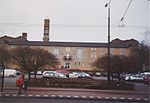KEMA Toren
1969 establishments in the Netherlands20th-century architecture in the NetherlandsBuildings and structures in ArnhemCommunication towers in the NetherlandsEuropean mast stubs ... and 2 more
Towers completed in 1969Towers in Gelderland

KEMA Toren is a 149-metre (489 ft) broadcasting tower built of reinforced concrete at Arnhem, Netherlands. It was built in 1969 by KEMA for communicating between high voltage substations throughout the Netherlands. It is now used for public radio and TV broadcasting. It is also known as TenneT Toren, after TenneT, the present owner of the tower.
Excerpt from the Wikipedia article KEMA Toren (License: CC BY-SA 3.0, Authors, Images).KEMA Toren
Utrechtseweg, Arnhem
Geographical coordinates (GPS) Address External links Nearby Places Show on map
Geographical coordinates (GPS)
| Latitude | Longitude |
|---|---|
| N 51.986327777778 ° | E 5.8759333333333 ° |
Address
TenneT Toren (KEMA Toren)
Utrechtseweg
6812 AR Arnhem
Gelderland, Netherlands
Open on Google Maps








